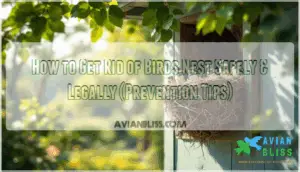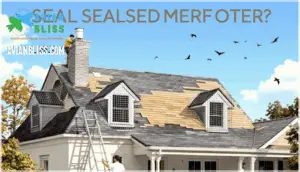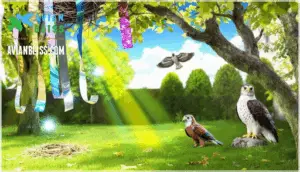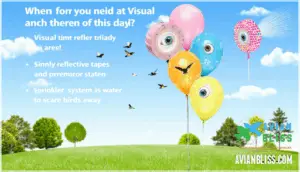This site is supported by our readers. We may earn a commission, at no cost to you, if you purchase through links.
 Last spring, a family of swallows built their mud fortress under my client’s front porch—charming until they realized those birds were federally protected and removing the nest meant risking a $15,000 fine.
Last spring, a family of swallows built their mud fortress under my client’s front porch—charming until they realized those birds were federally protected and removing the nest meant risking a $15,000 fine.
Here’s the thing: over 1,100 bird species enjoy legal protection under the Migratory Bird Treaty Act, turning what seems like a simple home maintenance task into a potential legal minefield.
You can’t just grab a ladder and yank down any nest you find. The trick is knowing when removal is legal, which species are off-limits, and how to prevent birds from turning your eaves into their maternity ward in the first place.
Table Of Contents
- Key Takeaways
- Bird Nest Removal Considerations
- Why Birds Nest Around Homes
- Preventing Birds From Nesting
- Timing and Safety of Bird Nest Removal
- Bird Nesting Facts and Deterrents
- Alternative Nesting Sites and Deterrents
- Effective Solutions for Bird Nesting Problems
- Additional Bird Repellent Methods
- Frequently Asked Questions (FAQs)
- How do you stop birds from nesting in trees?
- How do you keep birds from nesting?
- What to do if a bird nest is empty?
- How to get rid of a birds nest?
- Can a bird nest be removed?
- How do I stop birds from nesting on my porch?
- How to get rid of bird nest permanently?
- Is it OK to remove a birds nest?
- What happens if you disturb a bird’s nest?
- What does it mean when birds make nests around your house?
- Conclusion
Key Takeaways
- Over 1,100 bird species are federally protected under the Migratory Bird Treaty Act, making it illegal to remove active nests—violations can result in fines up to $15,000 and six months in jail, so you must identify the species and confirm the nest is empty before touching it.
- The best time to legally remove a bird nest is during the building stage (before eggs appear) or after it’s been abandoned, but you need protective gear like gloves and respirators since nests harbor pathogens and parasites that pose health risks.
- Prevention beats removal every time—seal entry points with copper mesh, install bird spikes on ledges, move feeders at least 30 feet from your house, and use motion-activated deterrents to make your property unappealing before nesting season starts (typically March through August).
- Heavy-duty solutions like bird netting, solar panel deterrent kits, and swallow shields offer permanent exclusion when basic deterrents fail, while alternative nesting sites like birdhouses in nearby trees redirect birds away from your home without legal or ethical complications.
Bird Nest Removal Considerations
Before you pull down that nest, you need to know the rules—federal law protects most bird species, and removing the wrong nest could land you in legal trouble. Identifying the bird species and understanding proper removal procedures isn’t just about following the law; it’s about doing right by wildlife while reclaiming your space.
Let’s break down what you need to think about before you take action.
Federal Laws Protecting Bird Species
Federal protections for birds aren’t something to take lightly—you could face serious penalties if you disturb the wrong nest. The Migratory Bird Treaty Act covers over 1,100 species, and violations can result in fines up to $15,000 and six months in jail for first offenses. Before removing any nest, you’ll need to identify the species and understand which federal regulations apply.
Here’s what protects our feathered friends:
- Migratory Bird Treaty Act (MBTA) safeguards most common backyard birds
- Endangered Species Act (ESA) protects 89 threatened or endangered bird species
- Bald and Golden Eagle Protection Act adds extra enforcement for eagles
- US Fish Wildlife Service oversees bird species protection and permitting
- Bird Conservation and Environmental Policies guide wildlife enforcement nationwide.
It’s essential to understand the federal bird laws to avoid unintentional violations.
Verifying Bird Species Before Removal
Before you touch that nest, you need to confirm what species built it—and trust me, this isn’t just birder trivia. Proper Bird Identification protects you from violating the Migratory Bird Treaty Act, which covers around 1,000 species. Use Nest Inspection tools like photo documentation and behavioral observation for Species Verification.
Wildlife Experts recommend checking databases that cover over 9,000 bird species to nail down your suspect. The US Fish Wildlife Service enforces Bird Species Protection and Bird Nest Removal Regulations, so getting Species Verification right through careful Nest Monitoring keeps you legal and the birds safe.
Understanding bird nesting habits is essential for effective conservation and safe nest removal.
Importance of Proper Removal and Relocation Procedures
Once you’ve confirmed which bird built the nest, how you manage removal and relocation can mean the difference between staying on the right side of the law and facing some serious fines. Legal Removal Procedures and Nest Removal Safety aren’t just suggestions—they’re requirements. Ethical bird nest removal process means respecting bird nesting behavior and using humane bird nest removal techniques. Professional Removal Services know Bird Relocation Methods and Wildlife Exclusion Tips that keep you compliant.
Here’s what proper bird nest removal involves:
- Confirm the nest is empty before touching it
- Wear protective gloves and masks during removal
- Use approved Nest Removal Methods that don’t harm birds
- Apply exclusion barriers immediately after removal
- Contact professionals if you’re unsure about any step
Why Birds Nest Around Homes
Ever wonder why birds seem drawn to your house like it’s prime real estate? Your home offers exactly what they’re looking for—safe shelter, cozy hideouts, and protection from threats.
Let’s break down what makes your property so appealing to our feathered friends.
Shelter From The Elements
When rain starts hammering down or a cold snap rolls in, birds aren’t thinking about your peace of mind—they’re scrambling to find cover, and your home’s cozy nooks look like five-star hotels. Overhangs, eaves, and vents offer prime weather protection and elemental barriers where birds can stash nesting materials and build secure bird nests away from wind and moisture.
| Weather Challenge | What Birds Seek | Common Nesting Sites |
|---|---|---|
| Heavy Rain | Dry, covered roosting sites | Soffits, porch ceilings |
| Strong Winds | Sheltered, stable bird shelters | Chimneys, alcoves |
| Cold Temperatures | Insulated nesting areas | Wall gaps, attic vents |
| Heat Exposure | Shaded bird houses | Covered eaves, awnings |
Protection From Predators
Birds aren’t just looking for a roof over their heads—they’re hunting for a fortress that keeps hawks, cats, and raccoons at bay. Your eaves and vents become safe havens with built-in roosting protection and nest camouflage. Here’s why your home works as a bird guard:
- Elevated ledges put nests out of reach from ground predators.
- Enclosed corners create natural predator deterrents that visual deterrents can’t match.
- Sturdy overhangs offer bird control advantages—better than any tree branch for dodging threats.
Attractive Nesting Sites for Birds
Your home’s design features—those gutters, vents, and cozy ledges—practically roll out the welcome mat for nesting birds. These spots check every box on their nest site selection wishlist: protection, stability, and easy access.
Here’s what makes your property irresistible:
| Location | Why Birds Love It | Prevention Strategy |
|---|---|---|
| Roof nesting areas | High vantage points with weather protection | Install copper mesh and gutter spikes |
| Soffit spaces | Enclosed, warm shelters perfect for raising chicks | Seal gaps with hardware cloth |
| Chimney habitats | Dark, protected cavities mimic tree hollows | Add chimney caps and guards |
| Dryer vents | Warm air flow attracts cavity nesters | Use vent guards with bird control features |
Without nesting prevention measures, bird attractants like these architectural features become prime real estate. Nesting site modification through strategic blocking stops bird nests before they start.
Bird Behavior and Nesting Preferences
Understanding what makes birds tick—and where they prefer to park their nests—gives you the upper hand in keeping them off your property. Different bird species have wildly different nesting habits and roosting behavior—some weave intricate nests from grasses and twigs, while others stake out ledges with minimal fuss.
Bird nesting patterns follow flocking behavior, with certain avian behavior favoring solitude and others clustering together. Knowing your local bird species and their nesting materials preferences helps you outsmart their site selection before they move in.
Preventing Birds From Nesting
The best defense against bird nesting problems is stopping them before they start. You’ve got several proven methods at your disposal, from physical barriers to sensory deterrents that make your property less appealing.
Here’s what actually works to keep birds from turning your home into their home.
Sealing Access Points and Gaps
Think of your home’s nooks and crannies as five-star real estate for birds—and you’re about to close up shop.
Grab some wire mesh and seal entry points around vents, soffits, and chimneys before nesting season kicks in. Install vent covers and chimney caps to block access, and don’t forget gutter guards to keep those gutters bird-free.
A little roof repair now beats dealing with bird netting and bird spikes later.
Installing Devices to Prevent Roosting
When birds start treating your eaves and ledges like their personal penthouse, it’s time to install some serious hardware that sends them packing. Bird spikes and roosting spikes create uncomfortable landing zones, while netting options block access to rafters and solar panels entirely. Here’s your arsenal:
- Spike installation: Transforms favorite perches into unwelcoming territory
- Bird deterrents with reflectors: Catch sunlight and spook incoming birds
- Strategic deterrent placement: Targets high-traffic roosting spots before they settle in
Regular device maintenance keeps your defenses battle-ready.
Using Reflective Objects and Predator Decoys
If you want to outsmart nesting birds without breaking out the heavy artillery, reflective objects and predator decoys are your secret weapons—cheap, simple, and surprisingly effective at making feathered squatters rethink their real estate choices.
Hang reflective tape, old CDs, or foil strips near problem areas—these shiny objects create disorienting flashes that birds hate.
Add predator decoys like plastic owls or hawks, but move them every few days so birds don’t catch on to your bluff. Together, these visual deterrents turn your home into unwelcoming territory.
Bird Repellent Sprays and Gels
For a more targeted approach, bird repellent sprays and gels work like invisible "keep out" signs that make surfaces sticky or smell downright offensive to birds—without you having to chase them around with a broom. Here’s what makes these bird deterrents effective:
- Spray formulas with peppermint oil make birds second-guess their landing spots
- Gel applications create uncomfortable, sticky surfaces birds can’t stand
- Repellent ingredients use natural scents that disrupt bird behavior and habits
- Spray nozzles let you target precise areas where birds keep returning
- Non-toxic bird repellents protect your home without harming wildlife
Reapply after rain to maintain effectiveness and keep those feathered squatters away for good.
Timing and Safety of Bird Nest Removal
Knowing when and how to remove a bird nest safely can save you from legal headaches and health risks. Timing matters—catching a nest early in the building stage is your best move, but you’ll need to verify it’s truly inactive before touching it.
Here’s what you need to know about safe removal, protective measures, and when it’s time to call in the pros.
Removing Nests During The Building Stage
Catching birds in the act—while they’re still gathering twigs and straw—gives you the perfect window to dismantle their setup without breaking any laws. At this stage, there aren’t any eggs or chicks, so you’re free to clear out those partially built nests and introduce bird deterrent systems right away. These nest removal tips work best as preventive measures before the situation escalates.
| Nesting Stage | Legal to Remove? | Best Action |
|---|---|---|
| Building (no eggs) | Yes | Remove immediately and add deterrents |
| Active (with eggs/chicks) | No | Wait or get professional help |
| Abandoned (empty) | Yes | Safe removal with protective gear |
| Complete but unused | Yes | Clear out and modify nesting site |
Quick action during construction prevents the need for humane bird removal later and keeps bird nests from becoming protected sites.
Ensuring The Nest is Inactive Before Removal
Before you pull down that nest, you need to confirm it’s actually empty—no eggs tucked in the back, no baby birds hiding under fluff, and zero signs of recent activity. Watch for bird activity around the site for a few days during nesting season—if parents aren’t coming and going, you’re likely safe.
Nest inspection and verification are critical preventative measures before attempting any humane bird removal, guaranteeing your nest removal methods stay legal and the birds stay protected.
Wearing Protective Gear During Removal
Once you’ve confirmed the coast is clear and that nest is truly empty, it’s time to gear up like you’re managing biohazard material—because, honestly, you kind of are.
Glove selection matters—thick rubber or nitrile works best against bird droppings and health hazards. Choose respirator use over basic mask types to block bird diseases, add eye protection, and consider safety suits for larger bird nest removal methods.
Contacting a Professional Wildlife Exclusion Company
Sometimes the smartest move isn’t doing it yourself—it’s calling in someone who won’t accidentally break federal law or end up covered in mites. Wildlife experts offering exclusion services and professional removal know which nests are protected, manage animal relocation properly, and install bird control systems that actually work. They’ve got the permits, the gear, and the know-how to keep your home bird-free without landing you in legal hot water.
Bird Nesting Facts and Deterrents
Understanding when and why birds nest helps you stay one step ahead of them. Knowing what attracts birds to your property—and what makes them think twice—gives you the upper hand in keeping your home bird-free.
Here’s what you need to know about bird behavior and the deterrents that actually work.
Nesting Season for North American Birds
Nesting season timing is everything when you’re dealing with bird nests around your property. Most North American birds get busy between early March and late August, with May through July seeing the heaviest action. Here’s what shapes their nesting cycles:
- Regional patterns shift dramatically—Florida birds may nest October through March, while Alaska’s season runs May 15 to June 25.
- Climate impact pushes southern birds to start earlier and nest longer than northern species.
- Avian behavior varies wildly—American Robins might nest 4-5 times yearly, while Great Horned Owls start in mid-February.
- Wildlife conservation laws protect these nesting cycles, so timing your removal matters legally.
Understanding bird migration and nesting season timing helps you plan removal safely.
Disturbing a Nest and Its Consequences
Tampering with bird nests triggers serious consequences you need to understand. Nest Disturbance Effects include skyrocketing abandonment rates—cavity-nesting birds in urban areas abandon nests ten times more frequently than undisturbed populations. The Bird Stress Response means parents may flee permanently, leaving eggs or chicks to die. Predation Risk Increase jumps dramatically after disturbance, as gaps in parental care attract predators.
The Migratory Bird Treaty Act makes disturbing active nests illegal for over 1,000 protected species, with steep penalties regardless of your intentions. Understanding these Conservation Implications helps you respect Nesting Season Timing and protect wildlife conservation efforts while addressing your bird nests problem legally.
Bird Diets and Food Sources
Understanding what keeps birds coming back to your property starts with knowing what’s on their menu—because food sources are the invisible thread tying them to your space. Different species have distinct seed preferences, insect consumption rates, and fruit diets that dictate where they’ll build.
Hummingbirds chase nectar feeding opportunities, while others hunt bugs near water sources. If you’re running bird feeders or leaving food accessible, you’re rolling out the welcome mat for avian pests.
Smart wildlife management means controlling these attractants before they turn your eaves into prime bird nest real estate.
Motion-Activated Lights and Sprinklers
When surprise becomes your secret weapon, motion-activated lights and sprinklers flip the script on persistent nesters who’ve gotten a little too comfortable around your property. These deterrent systems startle birds with sudden flashes or splashes—think humane deterrent meets wildlife control genius.
Adjust sensor sensitivity and sprinkler range to cover problem zones while keeping energy consumption reasonable. Pair them with visual and auditory deterrents for preventative measures that actually work, making your eaves far less appealing than that tree down the block.
Alternative Nesting Sites and Deterrents
Sometimes the best way to keep birds off your property is to give them somewhere better to go. If you make your yard less attractive while offering alternative spots nearby, birds will naturally choose the easier option.
Here are a few practical ways to redirect nesting activity away from your home.
Installing Birdhouses in Nearby Trees
If you want birds out of your eaves but don’t want to play the villain, give them a better option they’ll actually choose. Installing bluebird houses in nearby trees redirects bird nesting away from your home while supporting bird conservation. Here’s how to make it work:
- Tree Selection and Installation Tips – Mount birdhouses 5-15 feet high on sturdy trees away from your house, ensuring they’re stable and protected from strong winds.
- Birdhouse Design for Bird Behavior – Choose designs that match local species’ preferences, with proper ventilation, drainage, and entrance hole sizes.
- Wildlife Attraction with Nesting Materials – Place natural materials like twigs and grass nearby to encourage birds to build their nests in the new location.
Trimming Bushes and Plants to Discourage Nesting
Just like adding birdhouses offers a welcome path, trimming those overgrown bushes and plants ensures they don’t roll out the red carpet for nesters. Regular pruning techniques and yard sanitation remove the dense cover birds crave. Here’s your action plan:
- Cut back dense shrubs during fall to eliminate hiding spots before nesting season hits.
- Choose open-branched plant selection in your landscape design—birds skip exposed areas.
- Practice consistent garden maintenance by removing dead branches that attract nesting site modification attempts.
- Apply habitat modification principles by spacing plants wider apart, making your property less appealing as a bird nesting prevention method.
These preventative measures put you back in control.
Avoiding Bird Feeding Near The House
Your bird feeder might be the very reason those nests keep popping up on your porch—birds follow the food, then stick around to raise their families.
Move feeders at least 30 feet from your house to practice proper feeder placement and bird seed control. Store pet food indoors and clean up spilled seed immediately as part of your yard cleanup tips.
Consider removing feeders entirely during peak bird nesting season to strengthen your garden protection through habitat modification.
Keeping Trash Well-Covered and Stored
Exposed garbage is like rolling out a red carpet for birds looking to scout their next nesting spot. Invest in trash can lids that lock tight—proper waste management and sanitation practices cut bird attraction fast.
Secure storage paired with regular outdoor cleaning strengthens your pest management strategy, helping with wildlife removal and property maintenance. Think of it as bird repellent that works while you sleep.
Effective Solutions for Bird Nesting Problems
When prevention alone isn’t cutting it, you’ll need stronger measures to take back your space. The right tools can make the difference between endless frustration and actually solving the problem for good.
Here are four battle-tested solutions that work in different situations around your property.
Heavy Duty Bird Netting for Residential and Commercial Settings
Heavy-duty bird netting acts as an invisible fortress around your property, blocking determined birds from turning your eaves, vents, and overhangs into their personal real estate. This proven bird control method works for both residential solutions and commercial applications, permanently getting rid of birds’ nests before they start.
Key benefits of netting installation:
- Durable netting materials withstand harsh weather and persistent pecking
- Flexible bird deterrents adapt to preventing bird nests in attic spaces, soffits, and balconies
- Cost-effective bird repellent that outlasts sprays and gels
It’s one of the most reliable ways to reclaim your space without harming wildlife.
Solar Panel Bird Deterrent Kit for Rooftop Solar Panels
Solar panels promise clean energy, but they also create cozy hideouts where pigeons and other birds love to roost—turning your investment into a feathered frat house complete with nests, droppings, and potential damage.
A Solar Panel Bird Deterrent Kit offers targeted panel protection through exclusion methods that block access without harming birds. Kit installation takes a few hours, and while cost analysis shows higher upfront investment than sprays, kit longevity delivers years of bird nesting prevention methods and sustained solar panel efficiency.
Swallow Shield Kit for Blocking Swallows
Swallows might be graceful in flight, but their mud nests stick to your eaves like unwanted gum on a shoe—and that’s where a Swallow Shield Kit comes in to block their favorite building spots before construction ever starts.
Here’s what makes these nest blockers your secret weapon:
- Easy DIY installation—no contractor needed for effective swallow deterrents
- Blocks access to eaves and overhangs without harming birds
- Durable roof guards withstand weather while preventing bird nesting year-round
- Works as preventative measures through nesting site modification before mud flies
- Compatible with most bird control methods for layered swallow repellents
This bird shield stops the problem at the source.
Copper Stuf-Fit Mesh for Sealing Small Crevices
Birds don’t need much of an invitation—sometimes a gap the width of your thumb is enough to turn your roofline into their permanent address, which is why Copper Stuf-Fit Mesh works so well for plugging those tiny but troublesome openings. This rustproof material’s durability makes mesh installation a breeze for sealing entry points birds exploit. Shape it to fit crevice sizes birds love:
- Block access under roofing shingles where nesting materials accumulate
- Seal conduit gaps and fixture openings as preventative measures
- Stop birds from wedging into vents using humane exclusion methods
- Provide cost analysis benefits—affordable DIY bird nest prevention
Additional Bird Repellent Methods
If netting and mesh aren’t cutting it, you’ve got a couple more tools in your arsenal. These methods work well for targeted problem areas where birds keep coming back.
Let’s look at two reliable options that can help you reclaim your space.
Avian Block Bird Repellent Pouches Using Grape Seed Extract
Grape seed extract might sound like something from your local health food store, but regarding keeping birds away, it’s surprisingly effective in repellent pouches that create a scent zone birds simply won’t cross.
These Avian Block pouches use natural ingredients that won’t harm the environment or your family. Hang them near potential nesting sites, and you’ve got a chemical-free bird control solution that’s both practical and safe—no harsh sprays or complicated installation required.
Stainless Steel Bird Spikes for Beams and Other Areas
Stainless steel bird spikes transform ledges, beams, and railings into no-fly zones without harming a single feather—just pure, effective deterrence that makes your property the last place birds want to land. These roosting spikes install easily on beams, preventing bird droppings and nest buildup before they start. Stainless steel resists rust and weathering, making it ideal for long-term animal control and beam protection.
- Durable deterrent systems that last years without maintenance
- Humane nest prevention that blocks landing without injury
- Easy bird spike installation on ledges, beams, and railings
- Stops bird droppings and mess before they become a problem
Frequently Asked Questions (FAQs)
How do you stop birds from nesting in trees?
Think of trees as nature’s apartment complex—you can’t evict tenants, but you can make the units less appealing. Tree pruning and branch trimming reduce attractive nesting sites, while tree netting physically blocks access. Bird repellents and nest deterrents like reflective tape discourage nesting birds from settling in.
How do you keep birds from nesting?
You can keep birds from nesting by using nest deterrents like bird spikes, seal entry points around your home, apply bird control methods such as reflective tape, and modify nesting sites before the season starts—wildlife management beats nest removal every time.
What to do if a bird nest is empty?
Once the coast is clear and nesting season wraps up, you’re free to manage empty nest removal safely. Wear gloves and a mask—nests harbor pathogens.
After nest removal, sanitize the area with disinfectant to eliminate bacteria and parasites, confirming ethical removal practices and proper post-removal measures.
How to get rid of a birds nest?
To safely remove an inactive bird nest, wear gloves and a mask for protection. Gently dislodge the nest, seal it in a bag, and dispose of it properly.
Then install bird deterrents and seal entry points to prevent future nesting site modification.
Can a bird nest be removed?
Can a bird nest be removed legally? Yes, but only if it’s empty. Federal law protects active nests with eggs or chicks, so proper bird species identification and nest removal methods matter.
Always follow legal removal guidelines and wear protective gear during nest cleaning procedures.
How do I stop birds from nesting on my porch?
Install bird netting, roosting spikes, or visual deterrents like reflective tape to block access. Remove food sources and seal gaps. Modify the nesting site by adding physical barriers. These bird control methods prevent porches from becoming attractive spots.
How to get rid of bird nest permanently?
Like Odysseus returning home only to find unwanted guests, you’ll need permanent exclusion strategies for bird nest prevention.
Block nesting habitats with heavy-duty bird netting, seal entry points with mesh, and install bird spikes on ledges.
These bird control measures and nest removal tips create lasting bird deterrent systems.
Is it OK to remove a birds nest?
It depends—nest removal laws under the Migratory Bird Act protect most species during nesting season timing. You can remove empty nests, but disturbing active ones risks legal consequences.
Check bird species protection rules, confirm removal safety precautions, and contact wildlife experts if unsure.
What happens if you disturb a bird’s nest?
Disturbing a nest during nesting season is like toppling a house of cards—everything collapses. Parents may abandon eggs or hatchlings, leaving them vulnerable. Some birds become aggressive, defending their territory.
Under the Migratory Bird Act, disturbing active nests is illegal, protecting nesting birds and their wildlife habitat.
What does it mean when birds make nests around your house?
Your home offers exactly what nesting birds need—shelter from weather and predators. Those cozy nooks under eaves, soffits, and porch roofs? They’re prime real estate.
Birds view your house as a safe haven for raising young, complete with nearby bird feeders and nesting materials.
Conclusion
Think of bird control like installing a telegraph line in 1850—you need to know the terrain before you string the wire. Understanding how to get rid of birds’ nests legally isn’t just about yanking down twigs; it’s about timing, species identification, and strategic prevention.
Seal entry points, deploy deterrents early, and you’ll avoid both fines and feathered squatters. When doubt creeps in, call a wildlife pro—they’ll manage the legal maze while you reclaim your eaves.
- https://oldworldgardenfarms.com/2023/04/20/keep-birds-from-building-nests/
- https://www.facebook.com/thesimplegardenlife
- https://www.birdsandblooms.com/birding/attracting-birds/bird-nesting/found-abandoned-bird-nest-baby-bird/
- https://www.fws.gov/story/nesting-season-bird-behavior
- https://ftp.dot.state.tx.us/pub/txdot-info/env/toolkit/350-01-gui.pdf













